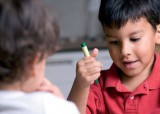Assessment for learning doesn't have to be a chore; and when used correctly, children will make far more progress, say Kevin Harcombe...
Assessment for learning doesn’t have to be a chore; and when used correctly, children will make far more progress, say Kevin Harcombe…
Assessment for Learning is not what the ad men would call a sexy title, but it is hot stuff in raising standards and accelerating pupil progress. AfL simply involves closing the gap between where children are and where they need to be. It’s about setting clear goals and providing detailed, timely feedback, so learners know where to go next and how best to get there. As such, it is vital to personalisation - giving children the chance to work collaboratively (with both teachers and peers) rather than being passive recipients of whatever is taught. Oh, and it’s not just about marking, though as Julie Andrews might have said, that’s a very good place to start.
There are some ground rules:
1. Make it relevant to the objective. We’ve all seen the lengthy writing piece where the objective was to make effective use of adjectives and adverbs and the comment from the teacher says something like, “Careful with your handwriting” or “Well done”. This level of critique is about as much use as a chocolate teapot. Feedback must always relate directly to the objectives and must be specific in setting out, briefly, what has been achieved, what is yet to be achieved and how to achieve it.
2. You can’t give detailed written feedback to every child on every piece of work, so don’t try. Focus on one group a day; peer and self marking can be used effectively in the other three groups.
3. There are ways of giving effective written feedback that won’t entail a world biro shortage. Such as…
Peer feedback won’t happen overnight. It takes time to train the children and groupings/pairings need to be carefully considered so they are neither too challenging nor too comfortable. The teacher also needs to model giving feedback to children as a first step in establishing peer assessment.
A Tricolour marking system can be very efficient. This is when work is self or peer-assessed using three different coloured highlighters to select three features: one that has been achieved, one that needs developing and one that is interesting. You may find the highlighter makes the writing vanish over the months. If so, use different coloured Post-its – even in a world of iphones and Xbox 360s, children inexplicably, though charmingly, find Post-its exciting.
Self assessment is the most difficult and so is often the weakest area, though it can be facilitated by talking partners. One way into selfassessment is through CUB scores. This is where children give themselves marks out of 10 for Concentration, Understanding and Behaviour. Any low scores need a justification. The children are very honest as they know only the teacher sees the scores. It also helps teachers identify those children who methodically get everything right but don’t really understand why/how. In time, children become so well practised they do this automatically.
A network schools project in my area highlighted this as one of the most effective AfL methods. The children liked the teacher’s personal comments and both child and teacher could see the scores rising as they became more skilled/confident. It also helps the teacher adjust shortterm planning – an important function of all AfL activity.
 Arguably, the most important aspect of AfL is dialogue and questioning because they are the means through which misconceptions are clarified and understanding deepens. Discussion should be centred on the children - the teacher chairs and facilitates a debate rather than ping-ponging between teacher-pupil-teacherpupil. That way, children are doing most of the talking and the teacher is guiding rather than leading. There needs to be an element of challenge in these discussions and guided reading sessions are a good place to begin. This is because you can establish dialogue and effective questioning in small groups where the ability range is relatively narrow. Philosophy for children also sets up good systems for discussion and gets children used to challenging and being challenged, as well as creating reflection time. Interview your pupils to find out if they feel involved in their learning and know how to improve. What do they think is the role of the teacher and peers in aiding their learning? How do they know when they are successful? Are they taught stuff they already know?
Arguably, the most important aspect of AfL is dialogue and questioning because they are the means through which misconceptions are clarified and understanding deepens. Discussion should be centred on the children - the teacher chairs and facilitates a debate rather than ping-ponging between teacher-pupil-teacherpupil. That way, children are doing most of the talking and the teacher is guiding rather than leading. There needs to be an element of challenge in these discussions and guided reading sessions are a good place to begin. This is because you can establish dialogue and effective questioning in small groups where the ability range is relatively narrow. Philosophy for children also sets up good systems for discussion and gets children used to challenging and being challenged, as well as creating reflection time. Interview your pupils to find out if they feel involved in their learning and know how to improve. What do they think is the role of the teacher and peers in aiding their learning? How do they know when they are successful? Are they taught stuff they already know?
You always start a new area of learning by asking what children already know and understand about it – you start from where they are. Pupils will improve most if they understand aims, where they are in relation to them and how to close the gap. This is learning how to reflect on learning as it happens.
The most frequent finding in Ofsted inspections is that assessment does not sufficiently inform teaching and learning. Don’t let them say that of you.
Have a second bite of the cherry – now!
Detailed written or oral feedback needs to be given in time for children to have a second attempt at the task or part of the task, preferably within the same lesson. Waiting a week is a wasted opportunity. Timely and specific feedback improves motivation and self-esteem as well as learning.
Musical chairs and peer AFL…
Play some music and give children the length of the track to move to another seat, read that child’s work and write a comment. It may be that children will select who they want to peer assess, but if the teacher is canny in setting it up well the children will value each other’s comments. Kate Fripp, Deputy Head of Park Gate Primary, notes that “it becomes a bit like a hypnotic process if you always use the same music as they just automatically stand up and know what to do without instruction.” Children need to be trained to ensure their comments relate to the success criteria rather than superficial aspects such as presentation and spelling.
The X Factor is the ideal format for AFL…
For this assessment activity, children take on the roles of the X Factor judges and give feedback on peers’ work – the Simon Cowell character suggests something to improve, Sharon Ozborne/Cheryl Cole finds something to praise and the other judge (Louis Walsh?) comments on something they found interesting. The children enjoy wearing or holding coloured pictures of their characters, which is both fun and takes away the personal issues of commenting on a friend’s work.
For a change you could adapt this to Dragon’s Den, The Apprentice or anything else the children can relate to.
Can the class spot the deliberate mistakes?
 We have used this approach a lot in science and history. The teacher, or pupils, conducts an experiment. Some children are given clipboards and white coats and take on the role of ‘experts’, each specialising in a different area. Having watched the experiment, they feed back to the class about the good things they’ve notice and what needs improving. It’s easy to differentiate as a ‘Level 3 fair testing expert’ would be an appropriate role for a less able pupils, while a ‘Level 5 reliability of results expert’ offers more of a challenge.
We have used this approach a lot in science and history. The teacher, or pupils, conducts an experiment. Some children are given clipboards and white coats and take on the role of ‘experts’, each specialising in a different area. Having watched the experiment, they feed back to the class about the good things they’ve notice and what needs improving. It’s easy to differentiate as a ‘Level 3 fair testing expert’ would be an appropriate role for a less able pupils, while a ‘Level 5 reliability of results expert’ offers more of a challenge.
It’s a particularly useful exercise because children are helping the teacher assess the rest of the class while offering an insight into their own skill level at the same time. It also promotes discussion and dialogue throughout the class. Children love it when TAs or teachers model experiments and they have to spot the misconceptions and scientific errors (deliberate of course) .
Becoming a teaching school
Ace-Heads
Teaching five year olds to talk
Ace-Classroom-Support
How to use modelling to engage pupils with autism
Ace-Art-And-Design
